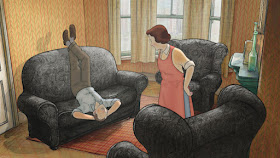 |
| Fig 1. |
"
Ethel & Ernest" (2016) dir.
Roger Mainwood, is a hand drawn animated feature film written by
Raymond Briggs and based upon his book of the same name. The film itself focuses on Briggs' own parents over their lifetime and largely tells the story of how they met, their experiences of living in wartime Britain and beyond that. As such, it's an extremely personal tale without an inkling of agenda, bearing the fruit of a story which packs a sentimental wallop to back up it's charming watercolour draping.
 |
| Fig 2. |
Briggs's previous work features the same altogether pleasing linework; Of those efforts, Tim Robey writing for the Telegraph enthuses that
"
The English writer and illustrator Raymond Briggs has bequeathed things, famously, to the art of animation – not just the 26 minutes of shivery joy that is Channel 4’s version of The Snowman, but the 1986 feature version of his nuclear parable Where the Wind Blows". (Robey, 2016) Utilising the Briggs' aesthetics the film resembles one of his children's books in motion, with a slight lean towards Hergé in terms of character design. It results in a decidedly 'old' feeling, and provides a sense of British peculiarity in places, which is of extreme importance in setting the piece. Robey goes on to say, of the films director, "
Mainwood faithfully reproduces the colours and textures of Briggs’s book – the faded quality of the greens and browns, quaintly suggestive of a make-do-and-mend mentality that couldn’t afford brighter hues. It’s a whole history of mid-20th-century, lower-middle-class life in England, even while it remains squarely rooted to one spot: the family home the Briggses never left." (Robey, 2016) This muddying of the waters, this deliberacy in giving us a softer reality, becomes the crux of a kind of conversation between the viewer and the film. This is both a telling of something that did happen, and a perhaps, wistful, recounting of the past, enshrined in gloriously - almost kitsch - locales and warm, inviting colours. This is a film that wants to be seen, not because it has a message per se, only that it highlights the very real state of happiness in building a life, and sadness when that life wanes. These almost universal themes lend weight to the otherwise cutesy visuals, and as such, are the true success here.
 |
| Fig 3. |
Beyond its usage as a way into Briggs's familial existence, "
The film touches on some dark subject matter - neighbours whose sons have been killed in the war, the schizophrenia of Raymond’s girlfriend – but does so with a very British restraint. It is also quietly satirical about the British class system and changing social attitudes – but it never patronises its characters." (Macnab, 2016). These quieter issues insinuate themselves within the story and go a long way in making it seem that much more real. It's by and large because of these smaller moments that the film transcends what would normally be considered garish nostalgia piece, into a far more nuanced and moving story. This is surmised in Robey's review of the film where he says that "
The ordinariness of this relationship, though, is just what makes it special, both on the page and floating by in Roger Mainwood’s adaptation." (Robey, 2016) and this is important in considering the briskness of the pace, as effectively the film succeeds or fails based on your willingness to buy into the
format.
In essence, the film is a slow burn montage sequence, taking great lengths to pass the audience through the greatest amount of time, and thus, further along the course of the Briggs's lives. Peter Bradshaw of the Guardian notes that "
The story moves briskly, even faintly incuriously through events, never staying all that long on each one." (Bradshaw, 2016) though this approach may turn some people off, perhaps those who might yearn for a more definite story. However, Bradshaw also notes that "
It’s an engaging film, but it leaves you with a feeling that there might be a deeper, darker, more specific story yet to be told." (Bradshaw, 2016) Be that as it may, this approach lends itself well here and in fact amplifies the reality on display. The stories surrounding the main ones displayed herein are paramount in situating the film in our reality, making the story, and it's outcome, all that more impactful and personal. Perhaps it is also because the characters of Ethel and Ernest play on a far more knowing and altogether 'cozy' level, that evokes archetypes familiar to all of us. Certainly if not exposed directly in our day to day lives then somewhere on the peripheries, again heightening the universality the film has. This, coupled with the films ending; an ending that would put even the harshest cynic to the test, makes "
Ethel & Ernest" an incredibly poignant tale indeed.
Bibliography
Bradshaw, Peter. (2016) "Ethel & Ernest review – moving adaptation of Raymond Briggs's graphic novel" theguardian.co.uk. At: https://www.theguardian.com/film/2016/oct/27/ethel-ernest-review-moving-adaptation-of-raymond-briggss-graphic-novel (Accessed 26/03/17)
Macnab, Geoffrey. (2016) "Ethel & Ernest review: Wonderfully evocative" Independent.co.uk. At: http://www.independent.co.uk/arts-entertainment/films/reviews/ethel-ernest-film-review-a7381006.html (Accessed 26/03/17)
Robey, Tim. (2016) "Ethel & Ernest review: Raymond Briggs honors his parents with slow-drip poignancy" Telegraph.co.uk. At: http://www.telegraph.co.uk/films/0/ethel--ernest-review-raymond-briggs-honors-his-parents-with-slow/ (Accessed 26/03/17)
Illustrations
Fig 1. Ethel & Ernest Poster. [image] At: http://www.filmfund.lu/var/www/storage/images/www/laptop/film-catalogue/films/ethel-ernest/55899-11-eng-GB/ethel-ernest_producer_logo.jpg (Accessed 26/03/17)
Fig 2. Ethel & Ernest relax. [image] At: http://www.filmfund.lu/var/www/storage/images/media/images/q016c005_compositing.0001/65548-1-eng-GB/q016c005_compositing.0001_film_lightbox_gallery.jpg (Accessed 26/03/17)
Fig 3. Family. [image] At: http://film.britishcouncil.org/images/EthelErnest.jpg (Accessed 26/03/17)




Well, after going through this post, I believe that my sister is going to like this movie. She is younger to me and I watch a lot of movies with her. Last month, we found shows by Andy Yeatman on Netflix as well. I am having a good time watching it with her.
ReplyDelete